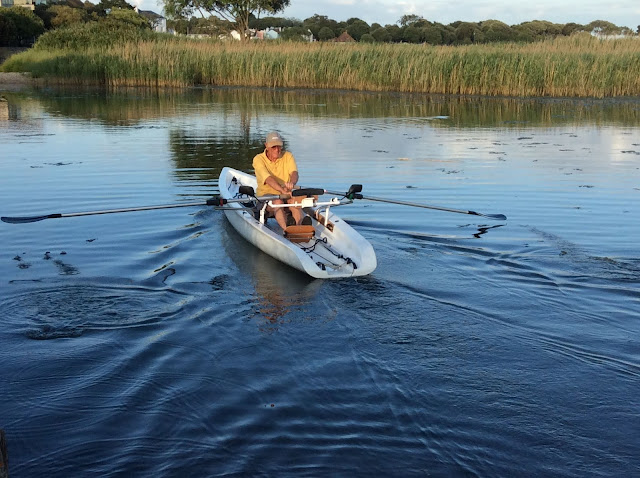Rowing at Sea
Capsize practice - getting back in the boat
Training for the RowClick 'READ MORE' to see more info.
Before owning this Yole I had never rowed a scull with a sliding seat and oars that have to be feathered (blades leveled on the backstroke). My rowing technique was mainly learned from Youtube and would probably be criticised by a rowing club coach. However it seems to work for me so since last November I have been training by rowing up, down and around Christchurch Harbour for 1-2 hours or more, usually covering 4 to 7 miles and up to just over 10 miles.
In the last few weeks I have also been able to get rowing out to sea on about six occasions. The biggest problem is getting out and back into the Harbour through 'The Run', the narrow channel past Mudeford Quay and extending about a quarter of a mile out to sea.
The entire contents of Christchurch Harbour, plus flow from two rivers, are emptied out to sea and then refilled twice each day, through The Run. At times the flow is almost twice as fast as I can row. It swirls in various directions and in addition waves or breakers from shallows on the side can sweep across the channel, often then bouncing back off the quay wall. This means that I can only row in or out around high tide when the flow eases and if the waves are not too big, also with luck when no other boats are entering or leaving at the same time (my two oar tips are about 18ft apart and I am facing backwards when rowing).
Having got out when conditions are suitable, the next problem, after an hour or two of rowing and when the period of slack water has passed, is getting back in. I often land on Avon Beach or Hengistbury Head and wait for better conditions to get in.
I have found that I enjoy rowing at sea with 'small' waves but it can be difficult when the waves get a bit bigger. The boat is self-draining so any waves that come over the front or the back just drain out the back, although my stuff gets wet.
Since I will only start the IOW row when there are settled calm conditions, the only potential patches of rough water on my route are when passing Hurst and when going round the various headlands of the Island, which all need to be taken when the tides are slack.
Capsize?
We had some great weather over Easter, so I took the chance to practise a couple of capsizes. I leant over right the side until the boat tipped up and I fell in. The water was cold but the boat stayed upright and I was able to heave myself back in each time. I then turned the boat right over but found I couldn't get it back upright without being able to stand on the bottom and lift one side over. It's a very stable boat so even if I get tipped in I'm pretty certain that the boat will stay the right way up.
Not very elegant!
When I Start
Since I will decide to start only two days in advance, if you would like to know when I'm leaving and possibly follow my progress posts, I will send you an email 1-2 days before starting if you email me on:
I will then send a (blind copy) single email giving my start date, and promise not to keep or disclose your email addresses.




Comments
Post a Comment